
Best 9 Must Have Tools for Inbound Marketing in 2024
Inbound marketing has become the cornerstone of successful online businesses. It’s all about attracting, engaging, and delighting potential customers through valuable content and experiences.
Staying ahead means wielding the right arsenal of tools for inbound marketing. As 2024 unfolds, businesses navigate a sea of possibilities with 9 indispensable tools at their fingertips.
These Tools for Inbound Marketing aren’t just optional for online business, they’re the lifelines of successful online endeavors.
Over 80% of marketers consider inbound marketing techniques effective, but only when equipped with the right resources.
With the ever-growing digital ecosystem, investing in the latest Inbound Marketing Tools isn’t a luxury, it’s a necessity.

In this article we’ll discuss the top 9 must have inbound marketing tools poised to revolutionize your inbound marketing strategies in 2024, empowering you to navigate the digital realm with finesse and drive unparalleled growth.
- What is Inbound Marketing?
- What is Inbound Marketing Tools?
- 1. TLinky – Ultimate Link Management Solution
- 2. HubSpot: Your All-in-One Marketing Solution
- 3. Semrush: Unleashing the Power of SEO
- 4. Mailchimp: Email Marketing Tool
- 5. Canva: Designing Visual Magic
- 6. Google Analytics: Tracking Success in Real-Time
- 7. Grammarly: Polishing Your Content to Perfection
- 8. ClickUp: Streamlining Project Management
- 9. Typeform: Capturing Insights with Interactive Forms
- Frequently Asked Question
- Conclusion
What is Inbound Marketing?
Inbound marketing is a customer-centric approach focused on attracting, engaging, and delighting potential customers through valuable content and experiences.
Unlike traditional outbound marketing tactics, inbound marketing aims to create meaningful connections by providing relevant and helpful information that addresses the needs and interests of the target audience.
Through strategies such as content marketing, social media, and SEO, inbound marketing seeks to build trust, establish authority, and ultimately drive organic traffic and conversions.

What is Inbound Marketing Tools?
Inbound marketing tools are essential resources used to execute inbound marketing strategies effectively. These tools encompass a wide range of software and platforms designed to attract, engage, and delight potential customers through various channels such as content creation, social media management, email marketing, SEO optimization, and analytics tracking.
1. TLinky – Ultimate Link Management Solution
TLinky revolutionizes link management with its comprehensive suite of tools designed to streamline your digital marketing efforts.
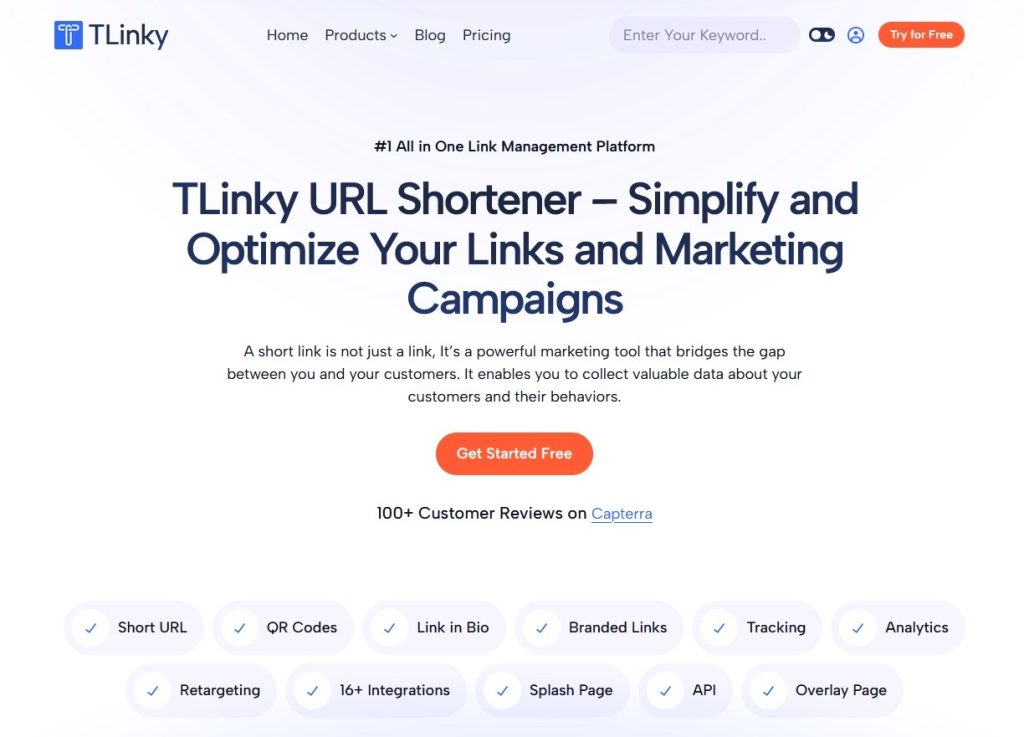
From URL shortening to QR code generation and link in bio page creation, TLinky offers a user-friendly platform to enhance your online presence.
With dynamic QR codes, customizable designs, and robust analytics, TLinky empowers businesses and individuals to optimize their marketing campaigns effortlessly.
TLinky Key Features:
- Dynamic QR Code Generation
- Customizable Designs to Match Your Brand Aesthetic
- URL Shortening for Concise and Professional Links
- Link in Bio Page Building for Social Media Optimization
- Advanced Analytics to Track Performance and Engagement
- Intuitive User Interface for Easy Navigation
- 16+ Seamless Integration with Marketing Tools
Pros:
- Versatile functionality catering to various marketing needs.
- User-friendly interface suitable for beginners and professionals alike.
- Robust analytics providing valuable insights for campaign optimization.
Cons:
- Advanced features may require upgrading to premium plans.
Pricing
| Plan Name | Monthly | Yealy | Lifetime |
|---|---|---|---|
| Free | $0 | $0 | $0 |
| Starter | $9 | $90 | $199 |
| Advanced | $29 | $290 | $399 |
| Business | $89 | $699 | $899 |
Best Hosting Solutions
- Best High Speed Web Hosting by Hostinger
- Low Cost Web Hosting Solution for Everyone by NameCheap
- Next-Gen VPS Hosting Solutions by Liquid Web
- Exclusive Website hosting by Inmotion Hosting
Best Cloud Hosting Solutions
Start Your eCommerce Online Store
Shopify eCommerce Online Store Builder for just $1
Marketing Tools
SEO Tools
#1 All in One SEO Tool – Semrush
2. HubSpot: Your All-in-One Marketing Solution
HubSpot is synonymous with an inbound marketing platform. It offers a comprehensive suite of tools for content creation, lead generation, email marketing, social media management, and customer relationship management (CRM).
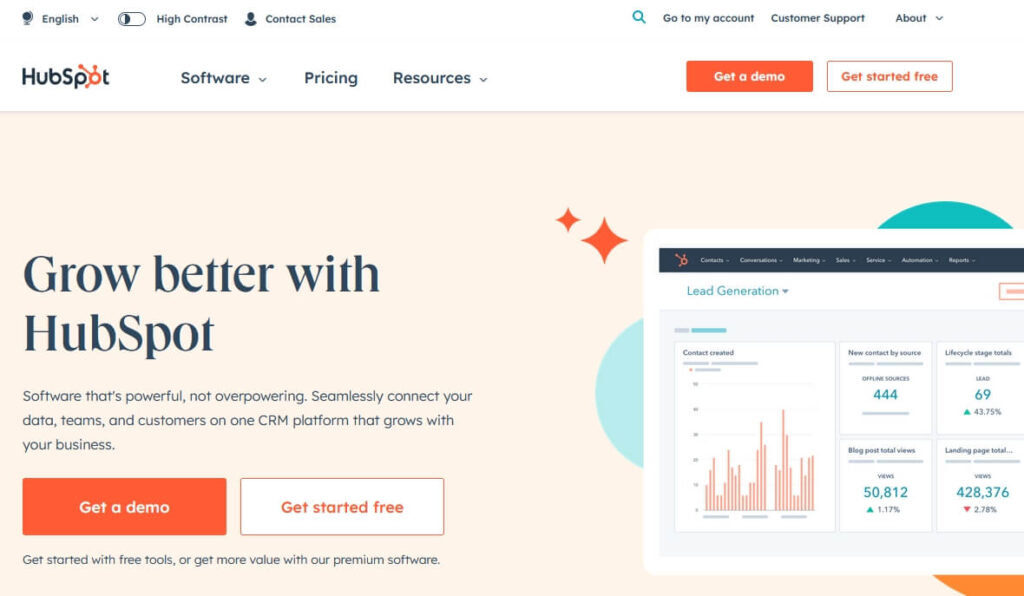
With features like lead scoring, marketing automation, and robust analytics, HubSpot empowers businesses to attract, engage, and delight customers throughout their buyer’s journey.
HubSpot Key Features:
- Marketing Automation: Automate repetitive tasks and nurture leads with personalized email sequences.
- CRM Integration: Seamlessly manage contacts and track interactions across marketing, sales, and customer service teams.
- Content Management: Create, publish, and optimize content for blogs, landing pages, and social media channels.
- Analytics Dashboard: Monitor campaign performance, track KPIs, and generate custom reports to measure ROI.
- Lead Scoring: Identify and prioritize high-quality leads based on engagement level and behavior.
- Social Media Management: Schedule posts, monitor mentions, and engage with followers across multiple social media platforms.
Pros:
- All-in-One Solution: HubSpot offers a comprehensive suite of marketing, sales, and customer service tools in one platform, streamlining processes and enhancing collaboration.
- Robust Analytics: The platform provides detailed analytics and reporting capabilities, allowing users to measure the impact of their marketing efforts and make data-driven decisions.
Cons:
- Complexity for Beginners: The extensive features and functionalities of HubSpot can be overwhelming for beginners, requiring time and training to fully leverage its capabilities.
- Costly for Small Businesses: While HubSpot offers powerful features, its pricing plans can be expensive for small businesses with limited budgets.
Pricing
- Starter Plan: Starting at $15 per month per seat, the Starter plan includes basic CRM features, email marketing, simple marketing automation, and form builder tools.
- Professional Plan: Starting at $800 per month with 3 seats, the Professional plan offers marketing automation, dynamic personalization, omnichannel marketing automation, custom reporting, and more.
- Enterprise Plan: Starting at $3,600 per month Including 5 seats, the Enterprise plan includes all Professional features plus advanced reporting, Multi-touch revenue attribution, Customer journey analytics, custom event triggers, predictive lead scoring, and more.
3. Semrush: Unleashing the Power of SEO
Search engine optimization (SEO) is the backbone of inbound marketing, and Semrush is the ultimate SEO toolkit.

From keyword research and backlink analysis to competitor tracking and site auditing, Semrush provides actionable insights to improve your website’s visibility and rankings on search engine results pages (SERPs).
Semrush:
- Keyword Research: Discover high-volume, low-competition keywords and analyze keyword trends over time.
- Competitor Analysis: Identify top competitors, analyze their strategies, and uncover new opportunities.
- Backlink Analysis: Audit backlink profiles, track new and lost backlinks, and identify link building opportunities.
- Site Audit: Identify technical SEO issues, optimize website structure, and improve site performance.
- Position Tracking: Monitor keyword rankings on search engine results pages (SERPs) and track performance against competitors.
- Content Marketing Toolkit: Analyze content performance, identify top-performing content, and uncover content gaps.
Pros:
- Comprehensive SEO Toolkit: Semrush offers a wide range of SEO tools for keyword research, competitor analysis, backlink auditing, and more, empowering users to improve their website’s search engine visibility.
- User-Friendly Interface: Despite its advanced features, Semrush maintains a user-friendly interface with intuitive navigation and helpful tooltips, making it accessible to users of all skill levels.
Cons:
- Learning Curve: Some of Semrush’s advanced features may have a steep learning curve for beginners, requiring time and practice to master effectively.
- Limited Free Version: While Semrush offers a free version with basic features, access to its full suite of tools requires a subscription, which may not be feasible for small businesses or individuals.
Pricing
- Pro Plan: Starting at $129.95 per month, the Pro plan includes basic SEO, PPC, Competitor analysis, keyword research, website audit, backlink analysis, advertising tools, and more for freelancers and startups.
- Guru Plan: Starting at $249.95 per month, the Guru plan includes all Pro features plus offers additional features such as Content Marketing Toolkit, historical data, multi-location and device tracking, Looker Studio integration, and more for larger businesses.
- Business Plan: Starting at $449.95 per month, the Business plan includes all Guru features plus Share of Voice, extended limits, API access, PLA analytics, free migration from third-party tools, and more for agencies and enterprises.
Note: Up to 17% discount for yearly payment.
4. Mailchimp: Email Marketing Tool
Email marketing remains one of the most effective channels in inbound marketing, and Mailchimp is the ultimate email automation platform.
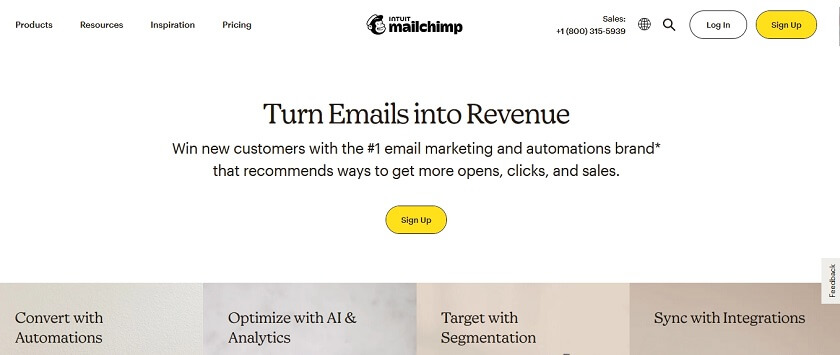
With its intuitive interface and robust features, Mailchimp stands out as top-notch inbound marketing software.
From designing beautiful email campaigns to segmenting your audience and analyzing campaign performance, Mailchimp helps businesses build meaningful relationships with their customers.
Mailchimp:
- Email Campaign Builder: Design and customize professional email campaigns with a user-friendly drag-and-drop editor.
- Segmentation and Personalization: Segment your audience based on demographics, behavior, and preferences for targeted messaging.
- Automation Workflows: Set up automated email sequences based on triggers such as sign-ups, purchases, or user behavior.
- A/B Testing: Test different email subject lines, content, and send times to optimize campaign performance.
- Analytics and Reporting: Track email open rates, click-through rates, and conversion metrics to measure campaign effectiveness.
- Integration Hub: Connect Mailchimp with eCommerce platforms, CRMs, and other tools to streamline data management and campaign execution.
Pros:
- User-Friendly Email Builder: Mailchimp’s drag-and-drop email builder and extensive template library make it easy for users to create professional-looking email campaigns without any design or coding skills.
- Automation and Segmentation: The platform offers powerful automation and segmentation features, allowing users to send targeted and personalized emails based on subscriber behavior and preferences.
Cons:
- Price Increases with Subscribers: While Mailchimp’s pricing plans start with a free tier for small subscriber lists, the cost increases as the subscriber count grows, potentially becoming expensive for businesses with large email lists.
- Limited Customer Support: Some users may find Mailchimp’s customer support options limited, especially for users on lower-tier plans, which may impact the timely resolution of issues or queries.
Pricing
- Free Plan: Mailchimp’s free plan includes basic email marketing features for up to 500 contacts and 1,000 monthly email sends.
- Essentials Plan: Starting at $6.50 per month, the Essentials plan offers additional features such as forms & landing pages, pre-built email templates, email scheduling, A/B testing, and custom branding.
- Standard Plan: Starting at $10 per month, the Standard plan includes all Essentials features plus advanced automation, comparative Reporting, Reporting & Analytics, Behavioral Targeting, and Dynamic Content.
- Premium Plan: Starting at $175 per month, the Premium plan offers all Standard features plus an increase in all feature limitations, and Premium Migration Services.
Note: All mentioned prices are for 12 months of payments.

5. Canva: Designing Visual Magic
Visual content is key to capturing audience attention, and Canva makes it easy to create stunning graphics, presentations, and social media posts.
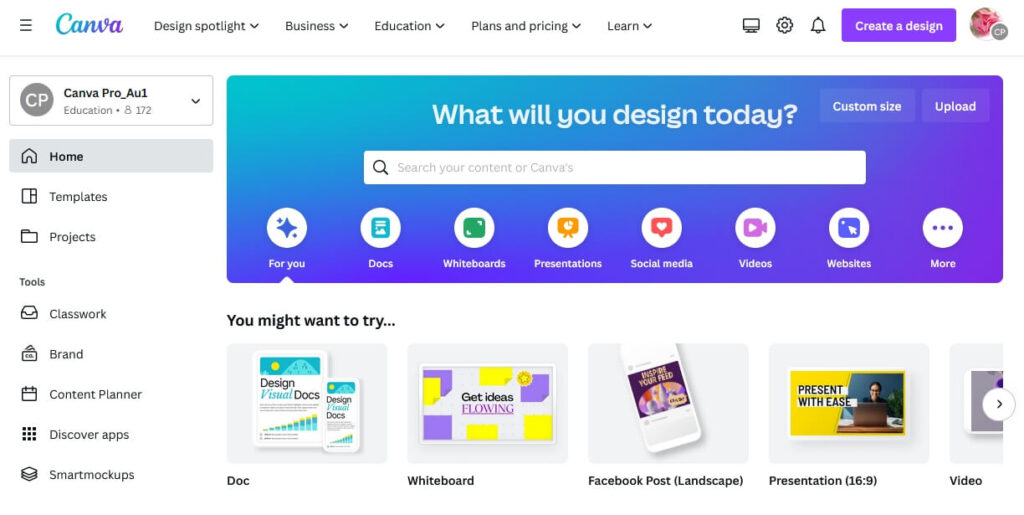
With its user-friendly interface and extensive library of templates and design elements, Canva empowers marketers to unleash their creativity without any design experience.
Canva:
- Drag-and-Drop Editor: Easily create custom designs by dragging and dropping elements onto the canvas.
- Templates Library: Access a vast library of professionally designed templates for various purposes and industries.
- Image Editing Tools: Edit photos, apply filters, adjust colors, and add text overlays with ease.
- Brand Kit: Maintain brand consistency by storing logos, colors, and fonts for easy access and use in designs.
- Collaboration Features: Share designs with team members, leave comments, and collaborate in real-time.
- Publishing and Sharing: Download designs in various formats or directly share them on social media platforms.
Pros:
- Ease of Use: Canva’s drag-and-drop editor and vast library of templates make it incredibly easy for users to create professional-quality designs without any design experience.
- Collaboration Features: The platform allows for seamless collaboration with team members, enabling real-time feedback and editing on shared designs.
Cons:
- Limited Customization Options: While Canva offers a wide range of templates and design elements, some users may find its customization options limited compared to more advanced design software.
- Premium Features Cost: While Canva provides a free version with basic features, access to premium templates and advanced design tools requires a paid subscription, which may not be affordable for all users.
Pricing
- Free Plan: Canva’s free plan includes basic design tools and access to thousands of templates and design elements.
- Canva Pro: Starting at $6.50 per month, Canva Pro offers additional features such as Unlimited premium templates, 100M+ photos, videos, graphics, audio, 100 Brand Kits to manage your brand, advanced design tools, 1TB of cloud storage, and team collaboration features.
- Canva Teams: Everything in Pro, plus: Scale your brand and centralize assets, Edit, comment, and collaborate in real time, Generate on-brand copy with AI, AI Admin Controls, and ISO 27001 certification and SOC2 type I compliance.
- Canva Enterprise: Canva also offers custom pricing for larger organizations with additional features such as single sign-on (SSO), advanced analytics, and custom integrations, and dedicated account management.

6. Google Analytics: Tracking Success in Real-Time
Data-driven decision-making is essential in inbound marketing, and Google Analytics is the go-to tool for tracking website performance.
From traffic sources and user demographics to conversion rates and bounce rates, Google Analytics provides invaluable insights into visitor behavior and campaign effectiveness.
Google Analytics:
- Real-Time Reporting: Monitor website traffic, user behavior, and conversions in real-time.
- Audience Insights: Understand your audience demographics, interests, and behavior patterns.
- Acquisition Channels: Track the source of website traffic and analyze the effectiveness of marketing campaigns.
- Goal Tracking: Set up and track goals such as form submissions, purchases, and newsletter sign-ups.
- E-commerce Tracking: Monitor sales performance, revenue, and product performance for e-commerce websites.
- Customization and Filters: Create custom reports, apply filters, and segment data to gain deeper insights.
Pros:
- Powerful Insights: Google Analytics provides in-depth insights into website traffic, user behavior, and conversion metrics, enabling businesses to make informed decisions and optimize their online presence.
- Free to Use: The platform is free to use for all website owners, making it accessible to businesses of all sizes and budgets.
Cons:
- Complex Interface: Google Analytics can be overwhelming for beginners due to its complex interface and extensive features, requiring time and effort to navigate effectively.
- Data Privacy Concerns: Some users may have concerns about data privacy and security when using Google Analytics, especially in light of increasing regulations and scrutiny surrounding online data collection.
Pricing
Google Analytics is free to use but, Google Analytics 360 starts at $50,000 per year but can go up to $150,000 (and even more) per year based on various factors.

7. Grammarly: Polishing Your Content to Perfection
In the world of inbound marketing, content is king, and Grammarly is the most popular inbound marketing tool that provides the ultimate writing assistant.
With its AI-powered grammar and spell checker, plagiarism detector, and writing style suggestions, Grammarly ensures that your content is clear, concise, and error-free.
Grammarly:
- Grammar and Spelling Checker: Detect and correct grammar, spelling, and punctuation errors in real-time.
- Writing Style Suggestions: Improve clarity, conciseness, and readability with style suggestions tailored to your audience.
- Plagiarism Detector: Ensure originality by checking your content against billions of web pages and academic papers.
- Vocabulary Enhancement: Expand your vocabulary and improve word choice with context-based suggestions.
- Browser Extension: Seamlessly integrate Grammarly into your writing workflow across various online platforms and applications.
- Personal Dictionary: Add custom words and terms to your personal dictionary for consistent spelling and style.
Pros:
- Writing Assistance: Grammarly offers comprehensive writing assistance with grammar and spell checking, style suggestions, and plagiarism detection, helping users improve the quality and clarity of their written content.
- Browser Integration: The platform seamlessly integrates with web browsers and other writing tools, providing real-time feedback and suggestions across various online platforms and applications.
Cons:
- Limited Features in Free Version: While Grammarly’s free version offers basic writing assistance, access to advanced features such as plagiarism detection and style suggestions requires a premium subscription.
- Overreliance on AI: Some users may feel overly dependent on Grammarly’s AI suggestions, potentially undermining their own writing skills and creativity.
Pricing
- Free Plan: Grammarly’s free plan includes basic grammar and spell checking features for writing in English.
- Grammarly Premium: Starting at $12 per month (when billed annually), Grammarly Premium offers additional features such as advanced grammar checking, Rewrite full sentences, Write fluently in English, style suggestions, and plagiarism detection.
- Grammarly Business: Starting at $15 per month (when billed annually), the business plan includes all Premium plan features plus Analytics dashboard, SAML SSO, Brand tones, and Centralized billing.

8. ClickUp: Streamlining Project Management
Effective project management is essential for keeping inbound marketing campaigns on track, and ClickUp is the ultimate project management platform.
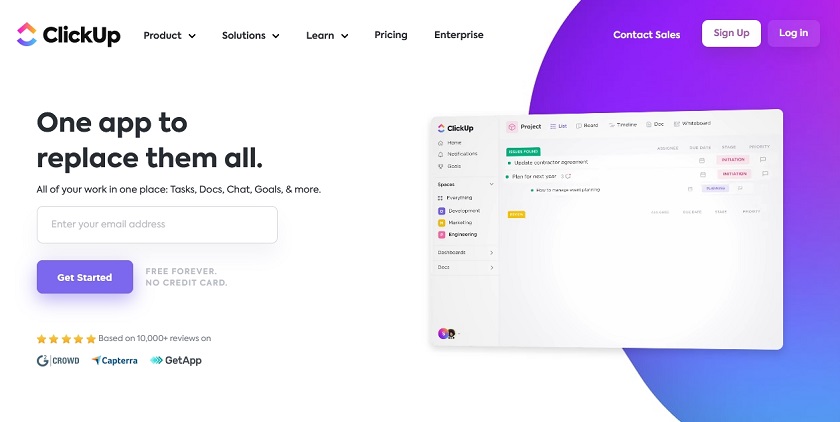
With features like task management, time tracking, and team collaboration, ClickUp streamlines workflow processes and enhances productivity.
ClickUp:
- Task Management: Create tasks, set due dates, assign responsibilities, and track progress within customizable task lists.
- Time Tracking: Monitor time spent on tasks and projects with built-in time tracking and reporting features.
- Team Collaboration: Collaborate with team members through comments, mentions, and file attachments within tasks.
- Customizable Workflows: Design custom workflows and task statuses to match your team’s unique processes.
- Integrations: Connect ClickUp with other tools and platforms to streamline workflows and centralize data.
- Document Management: Store and organize documents, files, and assets within ClickUp for easy access and sharing.
Pros:
- Customizable Workflows: ClickUp allows users to customize workflows and task statuses to match their unique processes, enhancing productivity and organization.
- Integration Capabilities: The platform offers seamless integration with a wide range of tools and platforms, enabling users to centralize data and streamline workflow processes.
Cons:
- Steep Learning Curve: ClickUp’s extensive features and customization options may have a steep learning curve for new users, requiring time and training to fully utilize its capabilities.
- Interface Complexity: Some users may find ClickUp’s interface cluttered or overwhelming, especially when managing large projects or teams.
Pricing
- Free Plan: ClickUp’s free plan includes unlimited users and unlimited tasks with basic features such as task management, docs, and integrations.
- Unlimited Plan: Starting at $7 per user per month, the Unlimited plan offers additional features such as unlimited storage, custom fields, and reporting.
- Business Plan: Starting at $12 per user per month, the Business plan includes all Unlimited features plus advanced permissions, Google SSO, Advanced Automation, Advanced Time Tracking, custom branding, and priority support.
9. Typeform: Capturing Insights with Interactive Forms
Understanding your audience is crucial in inbound marketing, and Typeform simplifies the process of collecting feedback and gathering insights.
With its intuitive form builder and conversational interface, Typeform engages respondents and delivers valuable data for informed decision-making.
Typeform:
- Interactive Form Builder: Create engaging and conversational forms with a user-friendly drag-and-drop interface.
- Conditional Logic: Customize form questions and paths based on respondent answers to create personalized experiences.
- Response Validation: Ensure data accuracy by setting rules and validation criteria for form responses.
- Multi-Channel Distribution: Share forms via email, social media, embedded links, and more to reach your audience wherever they are.
- Data Analysis Tools: Analyze form responses in real-time, visualize data with charts and graphs, and export data for further analysis.
- Integration Capabilities: Integrate Typeform with other tools and platforms to automate workflows and sync data seamlessly.
Pros:
- Interactive and Engaging: Typeform’s conversational interface and interactive form builder make it engaging for respondents, resulting in higher completion rates and better data quality.
- Conditional Logic: The platform’s conditional logic feature allows for dynamic and personalized form experiences, tailoring questions based on respondents’ previous answers for more relevant feedback.
Cons:
- Limited Free Plan: While Typeform offers a free plan with basic features, access to advanced functionalities such as conditional logic and customization options requires a paid subscription, which may not be feasible for all users.
- Integration Limitations: While Typeform integrates with popular tools and platforms, some users may find limitations in terms of available integrations or customization options.
Pricing
- Basic Plan: For $29 USD per month, the Basic plan offers 100 responses per month, 1 user, unlimited type forms, and unlimited questions.
- Plus Plan: At $59 USD per month, the Plus plan includes 1,000 responses per month, 3 users, everything in Basic, along with the removal of Typeform branding and a custom subdomain.
- Business Plan: Priced at $99 USD per month, the Business plan provides 10,000 responses per month, 5 users, everything in Plus, as well as drop-off rates, conversion tracking, and priority support & live chat.
- Enterprise: For customized pricing, the Enterprise plan offers tailored response limits & seats, VIP support & dedicated outcomes manager, custom domains & branding, Single Sign-On (SSO), HIPAA and GDPR compliance, and the option to select a preferred data center for optimal performance. Contact Sales for more details.
Frequently Asked Question
Why use inbound marketing?
Inbound marketing focuses on attracting, engaging, and delighting customers through valuable content and experiences. It helps businesses build trust, establish authority, and drive organic traffic and conversions, ultimately leading to long-term customer relationships and sustainable growth.
What are inbound leads?
Inbound leads are potential customers who have shown interest in a business’s products or services by engaging with its content or marketing channels. These leads are typically more qualified and receptive to marketing efforts since they have already initiated contact or expressed interest in learning more.
What is CRM in inbound marketing?
CRM, or Customer Relationship Management, in inbound marketing refers to the process of managing interactions and relationships with customers throughout their entire lifecycle. It involves capturing, storing, and analyzing customer data to personalize interactions, nurture leads, and provide a seamless customer experience.
Is SEO part of inbound marketing?
Yes, SEO (Search Engine Optimization) is a crucial component of inbound marketing. It involves optimizing a website’s content and structure to improve its visibility and rankings on search engine results pages (SERPs). By optimizing for relevant keywords and providing valuable content, businesses can attract organic traffic and generate inbound leads.
How can businesses choose the right inbound marketing tools for their needs?
Businesses should assess their marketing goals, budget, and requirements before selecting the tools that best align with their objectives and strategies.
What makes inbound marketing tools essential for modern businesses?
Inbound marketing software help businesses attract, engage, and delight customers through valuable content and experiences, driving growth and success in the digital era.
Can these tools be integrated with existing marketing platforms?
Absolutely, most of these tools offer seamless integration with other marketing platforms, ensuring smooth collaboration and data synchronization.
Are these tools suitable for businesses of all sizes?
Yes, these tools are scalable and adaptable to businesses of all sizes, from startups to enterprise-level organizations.
What is inbound vs outbound marketing?
Inbound marketing focuses on attracting customers through valuable content and experiences, whereas outbound marketing involves reaching out to potential customers through interruptive advertising or messaging. Inbound marketing emphasizes building relationships and providing value, while outbound marketing relies on pushing messages to a broader audience.
Is SEM inbound or outbound?
SEM (Search Engine Marketing) can include both inbound and outbound elements. While paid search advertising (PPC) falls under outbound marketing since it involves pushing ads to targeted audiences, organic search engine optimization (SEO) efforts are considered inbound marketing as they focus on attracting organic traffic through valuable content and optimizing for search engines.
Conclusion
Inbound marketing is a powerful strategy for attracting, engaging, and delighting customers, and the right set of tools can make all the difference. From HubSpot’s all-in-one marketing solution to Semrush’s SEO prowess and Canva’s design magic, each tool plays a vital role in maximizing marketing success. By leveraging these ten must-have tools, businesses can supercharge their inbound marketing efforts and achieve remarkable results in today’s digital landscape.
